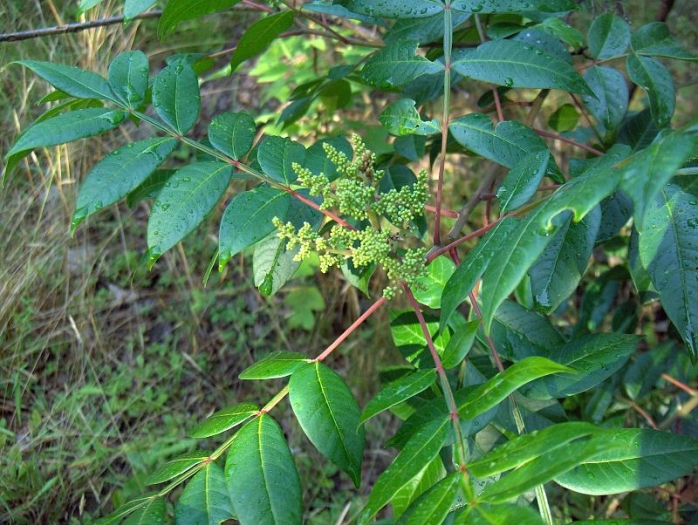Winged Sumac
(Rhus copallina)
Winged Sumac (Rhus copallina)
/
/

homeredwardprice
CC BY 2.0




































































Estimated Native Range
Summary
Winged Sumac thrives in a variety of soil types, including clay, loam, sand, slightly alkaline, acidic, and well-drained soils. It is highly drought-tolerant and can grow in full sun to part shade. The plant’s tiny, greenish-yellow flowers bloom in summer and are followed by showy red berry clusters that persist into winter, providing food for wildlife. While it has a high tolerance for salt spray and can be used in coastal plantings, gardeners should be aware of its underground runners that can lead to spreading. Care should be taken to avoid damage to the thin bark, and pruning may be necessary to maintain clearance for traffic or pedestrians. It is also suitable for container planting and land reclamation projects.CC BY-SA 4.0
Plant Description
- Plant Type: Tree, Shrub
- Height: 10-20 feet
- Width: 10-20 feet
- Growth Rate: Moderate
- Flower Color: Yellow, Green
- Flowering Season: Summer, Spring
- Leaf Retention: Deciduous
Growth Requirements
- Sun: Full Sun, Part Shade
- Water: Low
- Drainage: Fast, Medium, Slow
Common Uses
Bank Stabilization, Bee Garden, Bird Garden, Butterfly Garden, Deer Resistant, Drought Tolerant, Edible*Disclaimer: Easyscape's listed plant edibility is for informational use. Always verify the safety and proper identification of any plant before consumption., Erosion Control, Fire Resistant, Hummingbird Garden, Rabbit Resistant, Salt Tolerant, Showy Flowers, Street Planting
Natural Habitat
Open woodlands, forest edges, and fields across the Eastern United States
Other Names
Common Names: Black Sumac, Dwarf Sumac, Mountain Sumac, Shining Sumac, Upland Sumac, Korall-Sumach, Sumac Brillant, Flameleaf Sumac
Scientific Names: , Rhus copallina, Rhus copallinum var. latifolia, Rhus copallinum f. frondosa, Schmaltzia copallina, Rhus copallinum f. crispa, Rhus copallinum f. copallinum, Rhus copallinum f. integrifolia, Rhus copallinum f. latialata, Rhus copallinum f. serrata
GBIF Accepted Name: Rhus copallina L.